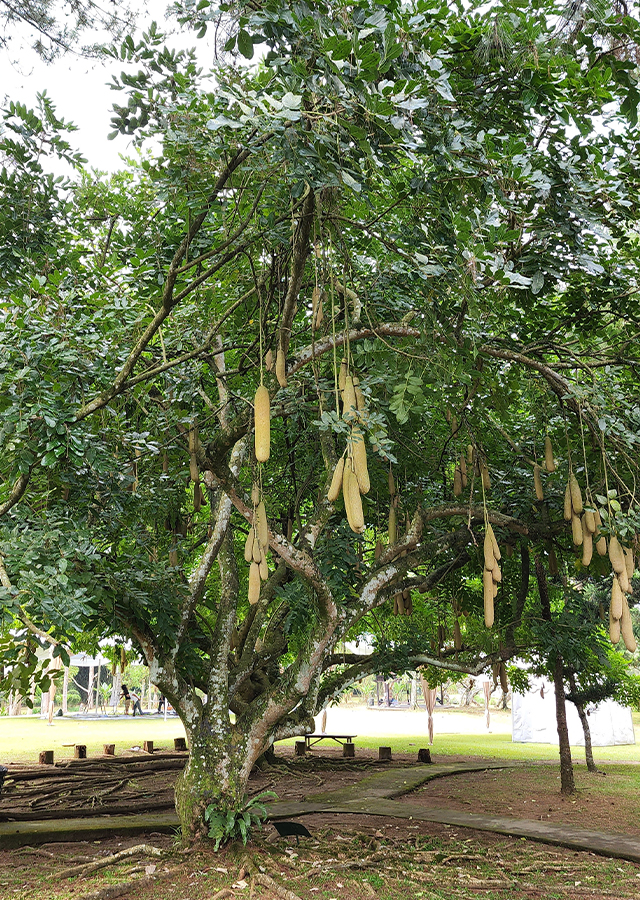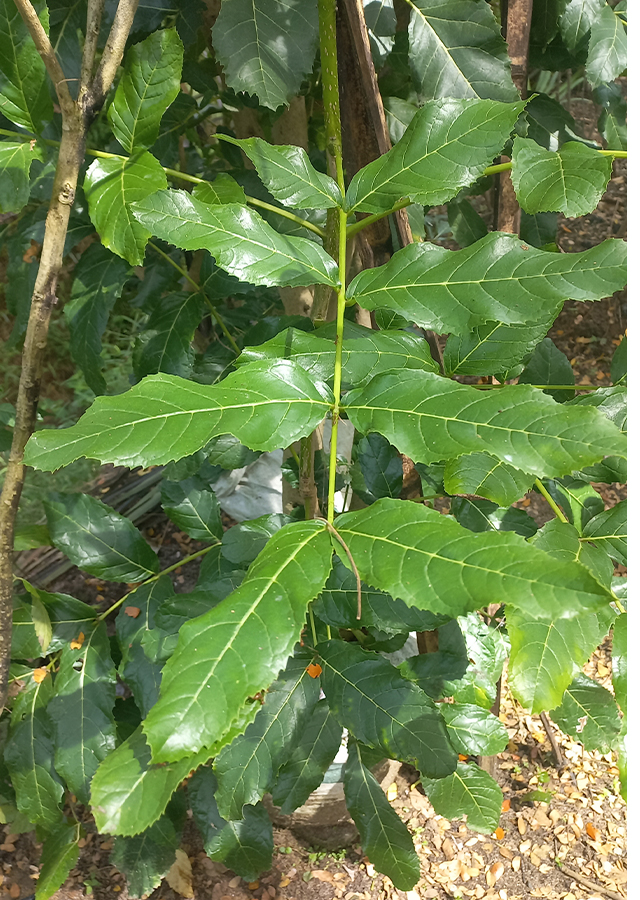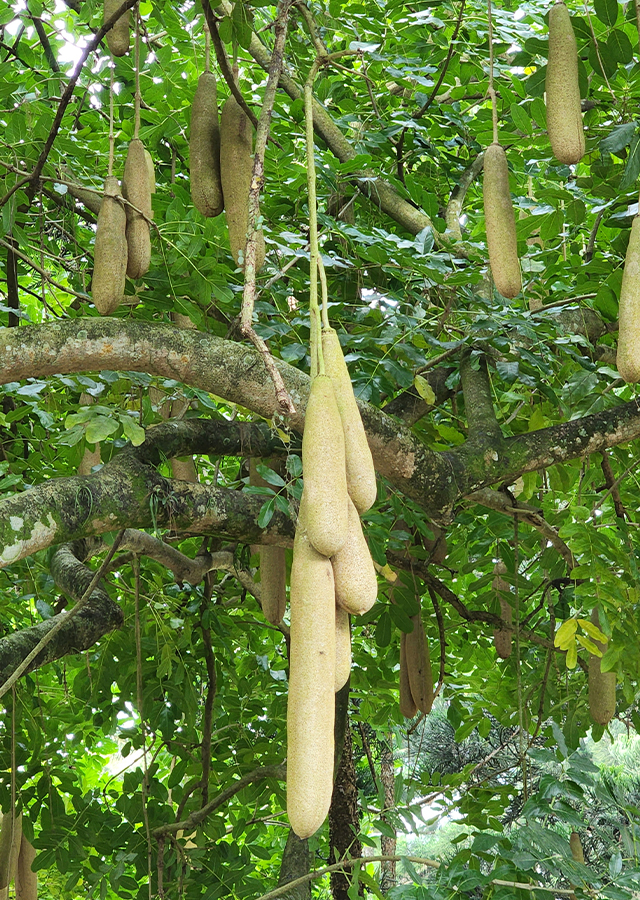Traditional Herbs from Kigelia africana
back_pain
- Take enough sausage tree leaves, wash them thoroughly.
- Crush them until they become a paste.
- Apply the leaf paste on your back.
What is Kigelia africana Looks like??



Parts of Kigelia africana that could be used
- Leaves
- Bark
- Fruit
- Roots
Kigelia africana Distribution
The sausage tree or Kigelia africana is a native plant and is widespread throughout tropical Africa. This species has also been introduced to several countries in Africa (Madeira, Canary Islands, Cape Verde, Réunion, Mauritius), the United States (California, Florida, and Hawaii), the Caribbean islands, Central and South America (Mexico, Honduras , El Salvador, Nicaragua, Costa Rica, Panama, Colombia, Venezuela, French Guiana, Ecuador, Peru and Brazil), West Asia (Israel, Iraq), South and Southeast Asia (Pakistan, India, Maldives, Sri Lanka, Myanmar, Thailand, Laos, Vietnam, China, Taiwan, Malaysia, Singapore, Indonesia and the Philippines), Australia and some Pacific Islands (New Caledonia, Guam and the Marquesas Islands). Kigelia africana is one species that has been widely exploited for its medicinal, religious and cultural values. Has many biological and pharmacological properties and activities. Various parts of the plant are used locally to treat various disease complaints. Traditionally, this species is used as a cosmetic for skin care, where Tongan women from the Zambezi valley use cosmetic preparations from the fruits to improve the skin and remove facial blemishes. In its native country, Kigelia africana is also considered sacred to many communities and is often protected when other forest trees are cut down. In Kenya, the Luo and Luhya people bury the fruit to represent the bodies of missing people believed to have died. Apart from that, Kigelia africana is also widely used by people as an ornamental plant, florist material (its fruit), shade plant, erosion control and river bank stabilization plant, source of materials (boards, fence posts, boxes, drums, chairs, tool handles, etc.) , black (comes from the flesh of the fruit) and yellow (from the roots) colorants, and an ingredient in the brewing process to aid fermentation and improve the taste of traditional beer. However, the fleshy part of the fruit is inedible and poisonous, which is intoxicating and can cause blisters on the tongue and skin.Agroecology of Kigelia africana
Sausage trees are usually found growing in the wild in wet areas along waterways, riverbanks, alluvial and open forests, savannas with high rainfall, bushes and rainforests. It thrives in many types of soil but prefers fertile, humus-rich and well-drained soil, usually found growing on red clay, sometimes rocky, damp or peaty textures, from sea level to a height of 3,000 m. This species likes places with rainfall throughout the year. Average annual rainfall ranges between 900 and 2,000 mm, but the species is deciduous in places with long dry seasons. It is best planted in warm areas, as this species is sensitive to frost, but young plants will survive if protected for the first three years. The growth of this species also likes conditions with full sun and is drought tolerant.
Morphology of Kigelia africana
- Stems thick, dark gray to light brown, thin scaly, peeling, low branching, branches and branches spreading and lenticelled.
- Leaves compound, arranged alternately (alternate), odd-pinnate (imparipinnate), no stipules, rachis up to 50 cm long. The leaflets are three to six opposite pairs, usually with terminal leaflets, elliptical to elongated-lanceolate, leaf apex abruptly shaped. pointed (acuminate), leaf base slightly asymmetrical, rounded to pointed (cuneate), leaf edges flat or sometimes slightly serrated, toothed, or wavy, shiny green above, and dull green below, glabrous to more or less hairy on both surfaces. Main lateral veins 7-12 pairs and prominent below.
- Flowers hermaphroditic, bisexual, large, 5-lobed, petals curved upwards. short bell-shaped to conical (campanulate), fleshy, has 5 irregular lobes, suddenly widens and curves upwards, lower lobes are generally longer when mature, yellowish green in color. The crown (corolla) is yellowish at first, then becomes dark red to purplish, the tube is cylindrical at the base and suddenly widens and curves upwards, the legs are bilabiate and have 5 lobes, the superior lip is bilobed, the lower lip is 3 lobes and curved, the lobes are less more rounded. Stamens four, attached to the corolla tube, staminode one. The ovary is cone-shaped, tapering into a slender pistil that resembles the stamen. Has a very unpleasant aroma, blooms at night, lasts only one night. Panicle inflorescences, terminal, each panicle contains 6 - 12 flowers.
- Indehiscent fruit, cylindrical sausage-shaped, hanging or pendulous, up to 50 cm long and 15 cm in diameter, woody walls with fibrous pulp, grayish brown -grey, marked with lenticels on the surface, elongated fruit stalk.\u00a0Usually weighs around 5 - 10 kg.
- The number of seeds numerous, wingless, ovate, thick, hard, testa rough, embedded in the pulp.
Cultivation of Kigelia africana
- Plant propagation is generative through seeds, and vegetatively using the cuttings method.
- Germination begins in 10 - 25 days. The germination rate is usually high and increases linearly with temperature in the range of 11 - 31 \u00b0C. Seedlings need shade for growth which is successful and does not perform well in direct sunlight.
Kigelia africana, more details :
Chemical Content of Kigelia africanaIridoids (specioside, verminoside, minecoside), quinones (lapachol, dehydro α-lapachone, 2-acetylfuro-1,4-naphthoquinone, kigelinol, kigelinone, isokigelinol, pinnatal, isopinatal, norviburtinal, sonovoburtinal, kigelinone, tecomaquinone-1, kojic acid,� 2-(1-Hydroxyethyl)-naphtho[2,3-b] furan-4,9-quinone, 2-acetylnaphtho[2,3-b] furan-4,9-quinone, 2-(1-hydroxyethyl ) naphtho [2,3-b] furan-4,9-dione), phenolic compounds (p-Coumaric acid, caffeic acid, ferulic acid, atranorin, nonacosanoic acid, 2-(4-hydroxyphenyl) ethyl ester, luteolin, luteolin 7-O-glucoside, 6-hydroxyluteolin, 6-p-coumaroyl-sucrose, kigeliol, racehonin), coumarin, sterols (β-sitosterol, stigmasterol , γ-sitosterol), triterpenes (oleanolic acid, acid pomolat, 2β,3β,19α-Trihydroxy-urs-12-en-28-oic acid), diterpenes (phytol, 3-Hydro-4,8-phytene), flavonoids, tannins, alkaloids, saponins.
Benefits of Kigelia africana
Treating diarrhea and dysentery, worms, pneumonia, toothache, eye pain, malaria, colds, flu, ulcers, gynecological disorders (venereal diseases), diabetes, kidney disorders, convulsions, postpartum hemorrhage, solar keratosis and skin cancer , back pain, boils, constipation, infertility, uterine cancer, hemorrhoids and rheumatism, epilepsy, cleaning and dressing flesh wounds and open wounds, scabs, skin diseases (fungal infections, boils, psoriasis, abscesses, eczema, herpes, acne), anemia (especially in pregnant women), edema, cataracts, jaundice, tumors and breast cancer, sexually transmitted diseases, lowers high blood pressure, general tonic to improve health and growth, improves breast development in young women, reduces breast swelling and mastitis, abortion (induces miscarriage), sexual complaints (infertility, impotence, poor libido), increases breast milk production. Has activity as antimicrobial, anti-inflammatory, anticancer, analgesic, antidiabetic, diuretic, antioxidant and antiaging.
Simplisia of Kigelia africana
- Prepare the sausage tree fruit, wash thoroughly with running water.
- Cut into pieces so they can dry easily.
- Dry in the sun or in an oven temperature\u00a040\u00b0C until the moisture content\u00a010%.
- Pure use a blender until it becomes powder.
- Store in a clean, airtight container.
Another Facts for Kigelia africana :
Synonym of Kigelia africanaBignonia africana Lam., Tecoma africana (Lam.) G.Don
Habitus of Kigelia africana
Tree. Tree, annual, up to 25(–35) m high, trunk diameter 60 cm, with a crown that is usually wide and round
Habitat of Kigelia africana
- Riverside", "Forest", "Roadside", "Bush Area", "Land
No comments:
Post a Comment